Recently I spotted a lovely bee flitting about as it fed from small anthericum flowers in the garden. Remarkably my camera was handy and I managed to snap a few photos. In an unusual turn of events, the bee obligingly stopped to preen allowing me to get a closer look.
Quite hairy with a striped although not really banded abdomen, the bee gripped a plant stem with its jaws and spent quite some time wiping its legs together and using its legs to groom its body and face.

The bee had been systematically visiting anthericum flowers (Chlorophytum saundersiae) before it paused to groom. All I knew was that this was likely to be one the solitary bees, which is hardly a narrow field. There are over 1000 species of bees in southern Africa – most of which are solitary bees, i.e. they do not live in hives or colonies like honey bees do.
After doing some reading I wondered if this bee is in the genus Amegilla – there are 32 species in southern Africa out of the 71 species of Amegilla that occur in sub-Saharan Africa. Amegilla are ground nesters, making burrows lined with a waterproof waxy substance that they produce as they go. In their burrows they construct cells which they then provision with pollen and nectar for their larvae.

Although it is possible that this bee is one of the Amegilla (even possibly Amegilla capensis) I can’t be completely certain. Perhaps I should extend the range of possibilities to include also the Anthophora genus. Species in the Amegilla and Anthophora genera form the vast majority of species in the Anthophorini tribe, referred to as digger bees. All the species are ground-nesting and they are described as being up to 3 cm long, robust, hairy and with visibly protruding faces. The wings are disproportionally short and the abdomen is often banded (Wikipedia).
Occurring in southern Africa are 31 out of the total of 51 Anthophora species found in sub-Saharan Africa. These numbers give some idea of the difficulty in identifying bees, even for specialists. So I am thinking that maybe I should extend the range of possibilities in identifying the bee and go even broader to the subfamily Apinae whose members include honey bees, stingless bees, some parasitic bees and sweat bees.
And to be even safer I could look to the entire family of Apidae, which also includes carpenter bees. But even going broadly I found further complexities – the Anthophorini tribe has recently (not sure when) been reclassified as part of the Apidae family and its previous family, Anthorphoridae, is now obsolete! And the Apidae family does not include leafcutter bees. They are in an entirely different family – Megachilidae.

Whatever its ID, the above photo shows how the bee is clinging onto a plant stem with its jaws. Many species of solitary bees (including those in the Anthophorini tribe) sleep at night by clamping their mandibles on a plant stem and tucking in their legs. All males sleep this way and unmated females (who do not have nests) do too.
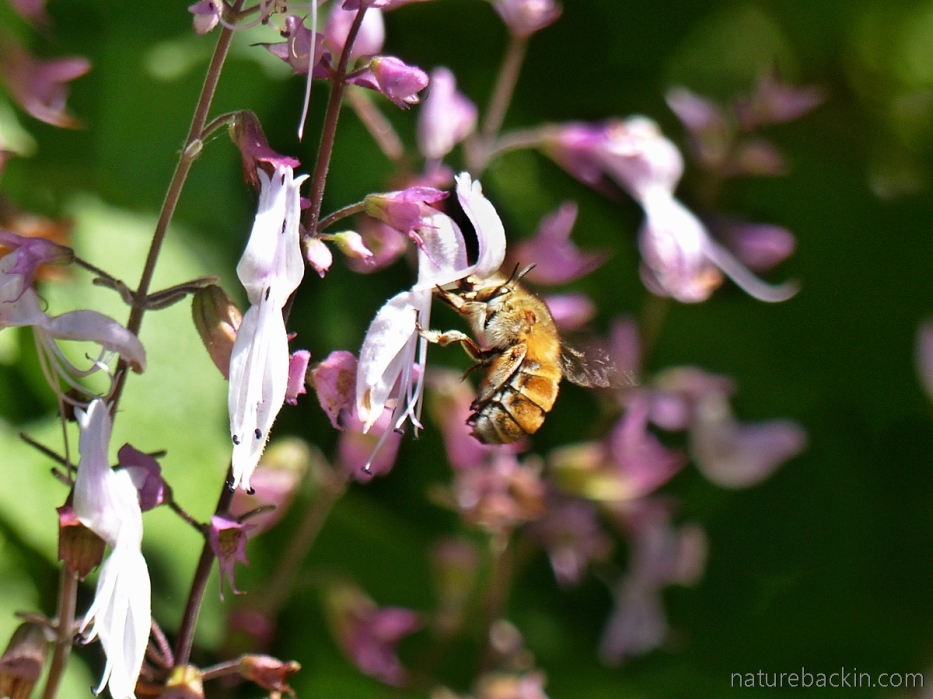
I think that it is the same species of bee in the photo above, this time visiting flowers on the shell bush (Orthosiphon labiatus).
I have posted previously on solitary bees and their diversity, but below are some other species of solitary bees that I have photographed since.

The rather hairy solitary bee in the photo above has a properly banded abdomen and is possibly an Amegilla. Perhaps it is a female taking a rest near her nesting burrow?
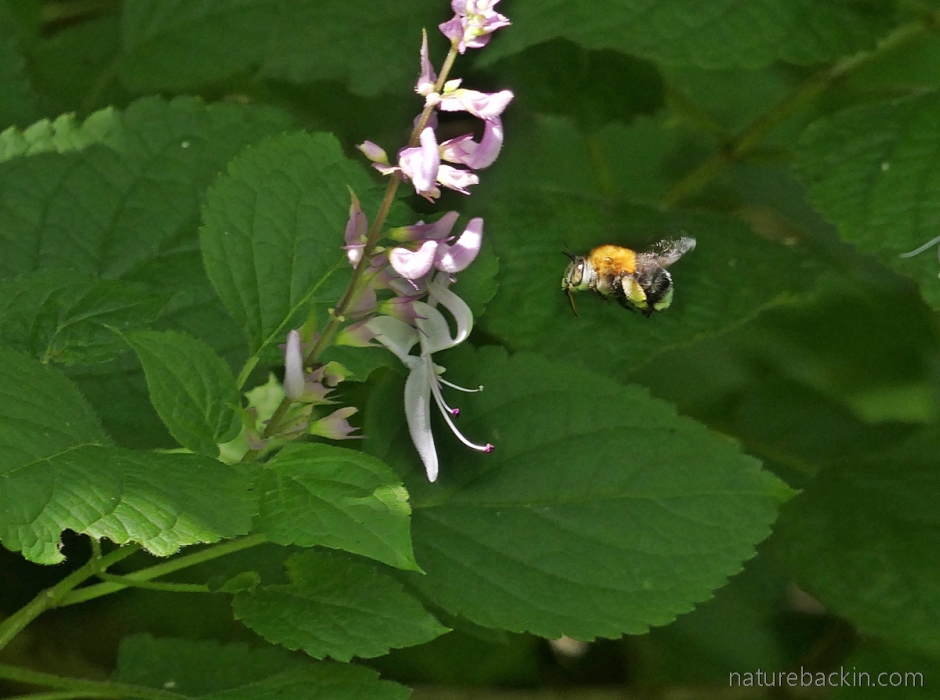
In this snapshot, a bee approaches a shell bush flower (Orthosiphon labiatus). I think that this attractive bee is possibly Amegilla mimadvena.
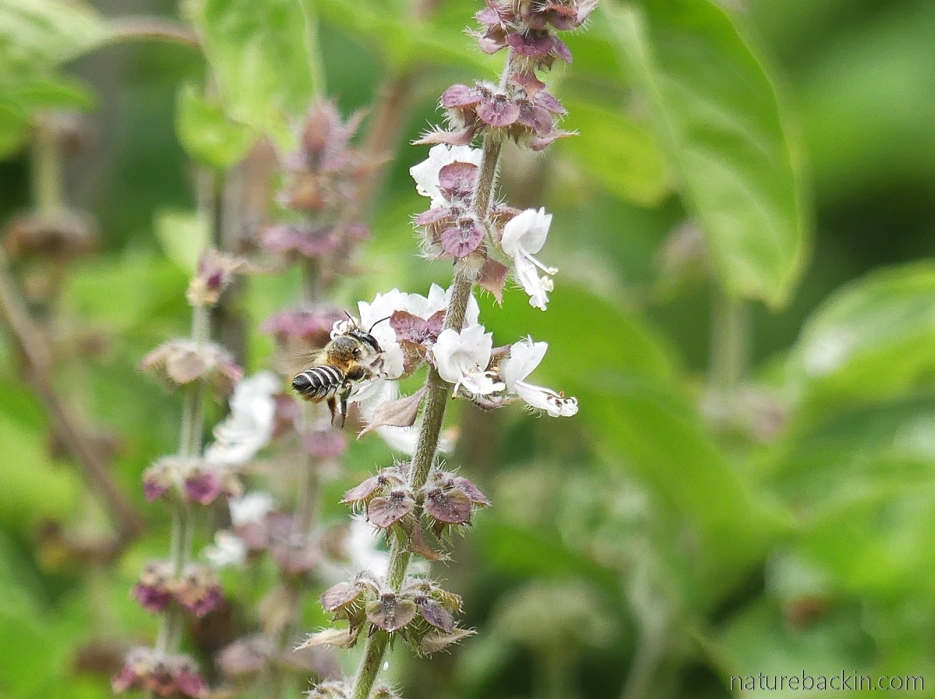
And this bee visiting flowers of a perennial basil plant in our herb garden had me foxed. Perhaps it is one of the leafcutter bees in the family Megachilidae?

And for something a bit different, in late autumn last year I came across this beautiful black and white bee warming up in the morning sunshine. I think this is likely to be a cuckoo bee in the genus Coelioxys, which is a member of the Megachilidae family, along with leafcutter and mason bees.

Above is a closer look in the bright morning sunshine at the same cuckoo bee. Female Coelioxys bees use the sharp point of the abdomen to penetrate nest cells in the nests of their host bees, often doing this while the host is out foraging and before the nest has been closed. These cuckoo bees mostly parasitize nests belonging to leafcutter bees (Megachile) and bees in the genus Anthophora.
Well in this post I have rather exceeded my insect identification abilities as well as the limits of my camera and I to photograph small, fast-moving insects. However, I wanted to share my enthusiasm for these beautiful wee beasties and a reminder that diverse solitary bees are highly efficient pollinators, and they play an important role in the pollination of crops across the globe.
Home gardeners can play their part in planting a diversity of plants for native pollinators. And in shunning the use of pesticides we can become friends of solitary bees and other wildlife too.
Sources:
Gess, Sarah K; & Friedrich W Gess. 2014. Wasps and bees in southern Africa. SANBI Biodiversity Series 24. Pretoria: SANBI. https://www.sanbi.org/documents/sanbi-biodiversity-series-24-wasps-and-bees-in-south-africa/
Picker, Mike; Charles Griffiths & Alan Weaving. 2019. Field Guide to Insects of South Africa. Cape Town: Struik Nature.
Wikipedia. 2021. Anthophorini. https://en.wikipedia.org/wiki/Anthophorini
See also:
A blog on the conservation of bees. http://ujubee.com/
AW Insect Book: Sawflies, Wasps, Bees & Ants (Hymenoptera) https://africawild-forum.com/viewtopic.php?t=3212&start=100
CandideZA. 2020. #PolliNationSA. https://candidegardening.com/ZA/stories/f4224184-cd62-4cdb-90fa-c5b0ba28aba1
Posted by Carol






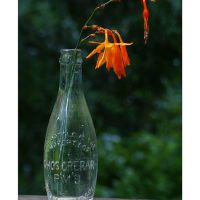
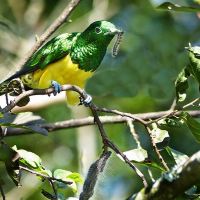
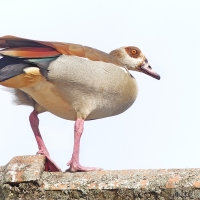
April 23, 2021 at 8:17 pm
Still trying to catch up here because I never fail to find something of interest or to learn something of value. I loved the thought of Sydney’s Woolworth’s stores launching the demonstration of what life might be like without bees. We have done battle with a neighbor who sprays Roundup trying to tame the blackberry vines. We’ve managed to keep her from overspraying onto our property, but she’s a senile old bat (with a gun) so we’ve leaned a bit on the side of caution. At least the younger folk appear to have a bit more awareness…. hopefully they’ll do a better job of it that our/my generation.
LikeLiked by 1 person
April 25, 2021 at 8:02 pm
Thank you Gunta. That is awful about your Roundup wielding neighbour and a difficult problem to deal with. I would expect that spraying it around would kill all the plants it touches and not just the blackberry vines?
I hope that the younger are more environmentally aware. Whatever happened to the hippies?!
LikeLike
March 11, 2021 at 3:23 pm
Thoroughly enjoyed your tribute to solitary bees, Carol. Terrific photos. Fascinating that they clamp on with their jaws. Your ID skills are much appreciated – I am always excited to come upon busy bees on flowers to admire and photograph. We must protect and save the bees! 🐝
LikeLiked by 1 person
March 12, 2021 at 6:43 pm
Thanks so much Jane. The solitary bees are really interesting. It has been dawning on me lately that we have no honey bees visiting currently. We wonder if the aftermath of the hailstorm (loss of flower buds for example) is a contributing factor, so we anxiously await to see if any honey bees turn up this autumn. Indeed we must protect our bees and other pollinators.
LikeLiked by 1 person
March 8, 2021 at 10:16 am
Oh gosh Carol! Those photos of the bees are awesome! I’ve been back to your post about 5 times just to study the photos! Thanks for the information on the solitary bees too. I had no idea that they clamped their mandibles onto the plant to sleep! I also love the photo of the rolled leaf nest. Bees are truly amazing creatures! We have a number of solitary bees here, the most common one being the blue-banded bee. I had not seen any this summer, and was concerned about that. Then on Sunday I saw one visiting the Salvia in the garden! I rushed to get the camera, but I’m afraid the photos I took of it come nowhere near the quality of your photos. I enjoyed reading your post!
LikeLiked by 1 person
March 11, 2021 at 11:01 am
Thanks so much. That must have been a good moment to see the visiting solitary bee. We are concerned here as there are no honey bees visiting currently. Because of the hailstorm last year damaging a lot of flowering plants there have perhaps been fewer flowers, although now there are flowers in bloom that should be attracting honey. Perhaps they have found better places to forage this summer …
Sorry to mislead re the dry leaf and the stripy bee – the leaf is incidental as the bee actually nests in burrows that it digs into the soil.
LikeLiked by 1 person
March 11, 2021 at 11:15 am
I was thrilled to see the solitary bee again! They are few and far between, and we do our best to encourage them! I hope your bee populations in the garden increase, if not now then again in spring. Oh that’s okay re the stripy bee! I saw the leaf and immediately thought it must be a leafcutter bee, and I was thrilled you had found one! We’d love to get a small hive of the native stingless bees for the garden. They are such interesting creatures!
LikeLiked by 1 person
March 12, 2021 at 6:39 pm
It is lovely to see solitary bees. I hope that the honey bees start visiting again – it is strange without them.
Btw, we have suspended small mixed bundles of bamboo and wooden sticks (about an inch in diameter and 12 inches plus long) under the eaves of the house. They are very popular with carpenter bees and some species of wasps for nesting.
LikeLiked by 1 person
March 13, 2021 at 9:38 am
Oh that is interesting! I might give that a try! Thank you!
LikeLiked by 1 person
March 6, 2021 at 5:50 pm
What a fascinating, beautifully photographed post, Carol. I’m passionate about all our garden bees so I really appreciated your sharing all that researched information.
I wondered if you’d read the linked article below ~ a real wake-up call!
https://www.news.com.au/lifestyle/food/eat/woolworths-neutral-bay-in-sydney-stripped-of-fruit-and-veg-due-to-bee-shortage/news-story/dc0ac42f17a75b094149d0852c0ef66c
LikeLiked by 1 person
March 6, 2021 at 7:30 pm
Thanks very much Alison. Although there are far bigger forces at play than home gardeners, I still think that gardeners should try to be wildlife and environmentally friendly, and provide havens for bees and other creatures wherever possible.
Thanks for the link to the article – what a powerful piece of activism from the Woolworths store. Definitely a wake-up call!
LikeLike
March 6, 2021 at 7:59 am
Well photographed, Carol! Like especially the facts about the beautiful cuckoo bee. Never heard about that insect.
LikeLiked by 1 person
March 6, 2021 at 7:04 pm
Thanks so much Simone. There are other species of cuckoo bees as well – very fascinating.
LikeLiked by 1 person
March 5, 2021 at 2:37 pm
Wonderful photos, speculations, and information about the solitary bees.
LikeLiked by 1 person
March 5, 2021 at 6:08 pm
Thanks so much Jet. I am learning as I go along 🙂
LikeLiked by 1 person
March 5, 2021 at 1:36 pm
Just beautiful. Love that first shot of the bee coming in to land, its wings vibrating mid-air.
LikeLiked by 1 person
March 5, 2021 at 6:07 pm
Thanks Amanda – catching the bee flying in towards the flower was a lucky shot 🙂
LikeLike
March 5, 2021 at 11:07 am
Wonderful! I only learnt about solitary bees a few years ago. Thanks for all the info.
LikeLiked by 1 person
March 5, 2021 at 2:44 pm
Thanks Nikki. I also discovered about them them relatively recently – lots to learn and enjoy!
LikeLike
March 5, 2021 at 9:21 am
So much to learn from your blog, Carol. Each and every time.
LikeLiked by 1 person
March 5, 2021 at 2:43 pm
Thanks for your kind comment Suzette. And I am learning too as I go along 🙂
LikeLike
March 5, 2021 at 9:07 am
Well, I have learnt something (again) from your blog. I did not know that solitary bees were a phenomenon — and that there are so many different kinds. Thank you for the remarkable photographs and fascinating information.
(Uncannily, just before I opened your post I spent quite a while coaxing a bee out of the window. It was stuck between the overlap of the top and bottom sash windows. I wonder if it was a solitary bee… )
LikeLiked by 1 person
March 5, 2021 at 2:42 pm
Thanks Mariss. I guess when stuck between the panes thus it could not help but be solitary …
How kind of you to rescue it and give its freedom back.
LikeLiked by 1 person
March 5, 2021 at 6:54 am
I think I have flies [mimiicking bees] in my garden, besides honey bees and bumblebees. Although they look similar, they fly more quickly and erratically than normal bees.
LikeLike
March 13, 2021 at 11:35 am
Although Canadian I found this blog post interesting re flies/bees https://laidbackgardener.blog/2019/08/14/one-fly-gardeners-should-learn-to-appreciate/#comments
LikeLike
March 5, 2021 at 3:53 am
Carol this is such a heart warming post, your photos are exquisite and I love the bees, plus all the information! xxx
LikeLiked by 1 person
March 5, 2021 at 2:39 pm
Thanks Christeen – they are delightful to see in all their rather fluffy detail 🙂 xxx
LikeLiked by 1 person
March 5, 2021 at 3:08 am
What a treat, Carol, even if their exact names remain a mystery for now. Just being able to identify the family opens a treasure chest of fascinating information. I, for instance, never knew about the fact that some bees sleep with jaws clenched around a stem or twig! Being prone to clenching my jaws in stressful situations, I feel rather sorry for them…
LikeLiked by 1 person
March 5, 2021 at 2:38 pm
It is true what you say about opening up fascinating information.
And as a fellow jaw-clencher I know exactly what you mean!
LikeLiked by 1 person
March 5, 2021 at 3:04 am
Great photos as always, and very informative. I’m afraid I get as far as honey bees, leaf cutters, and carpenter bees, so you’re way ahead of me. But you have so many varieties compared to here. There is a native bee here, but I’ve yet to see one let alone get a photo.
LikeLiked by 1 person
March 5, 2021 at 2:36 pm
Thanks Graham. I am trying to learn to observe better what I see and learn to see difference where before I just saw something vaguely generic. Sometimes it is fascinating and at other times it can be simply confusing!
I hope you get to see the native bee at some point!
LikeLiked by 1 person
March 5, 2021 at 5:43 pm
Well, you observe very well. I can get a bit lazy in that department. The native bees are pretty scarce at lower elevations these days, so it will be a case of making a trip to somewhere they tend to be more plentiful.
LikeLiked by 1 person
March 5, 2021 at 12:03 am
Very informative post, Carol! Solitary bees are wonderful little friends to have in the garden. I can barely get beyond ‘solitary bee’ for ID, and feel overwhelmed trying to get a genus and species, so well done!
I read that leaving mulch-free, bare, sandy spots in the garden helps our solitary bees find good nesting sites and others that nest/overwinter in plant stalks benefit from our waiting to do spring clean-up after the temps have risen to 55F(12C), so that last year’s pupae can hatch out. This last is hard for neat and tidy types, but works fine in my semi-wild garden.
LikeLiked by 1 person
March 5, 2021 at 2:15 pm
Thanks Eliza – I am grateful that I also got to learn about the existence of solitary bees!
I have also read that about having mulch-free undisturbed patches of soil for ground-nesting insects. An excellent point too about not pruning stalks and dry branches until larvae have likely hatched. If more people understood just how destructive the tidy garden convention is perhaps they would be happier to take a more relaxed and natural approach to gardening? Even if only some sections and corners are left to be more natural that would count for a lot in terms of conserving important little creatures such as solitary bees and many others too.
LikeLiked by 1 person
March 6, 2021 at 12:37 am
‘Messy’ gardening is beginning to gain traction… education is key to changing that paradigm here, and of ‘the Great American Lawn,’ a labor and water intensive monoculture bathed in chemicals. Such a bad idea!
LikeLiked by 2 people
March 6, 2021 at 7:03 pm
That is good to hear – that mindsets are beginning to change. Manicured lawns are a thing here too, unfortunately.
LikeLike
March 6, 2021 at 8:21 pm
Water is a precious commodity and it is a crime to use it so frivolously in a drought-prone area when a xerophytic, native plant garden is so within reach of most.
LikeLiked by 1 person
March 7, 2021 at 2:53 pm
I can’t imagine the stress people are going through in our drought-stricken areas and getting sand blasted by the wind tearing across the bare ground. I know that there are those with access to borehole water who try to keep a least a patch of lawn going as they find it comforting.
Pesticide use and lack of plant diversity are also issues associated with large and sterile lawns, even when lack of rain is not a major part of the problem …
LikeLiked by 1 person
March 8, 2021 at 10:18 am
Thank you both for the extra information on the bees re clear sandy patches and no pruning! I need to be more aware in my garden (mine is messy too!)
LikeLiked by 1 person
March 11, 2021 at 11:04 am
Yes it is interesting about the sandy patches and the pruning. I am constantly learning more too and trying to reduce the damage I do including inadvertently!
Messy gardens deserve a more flattering term as they are so full of life!
LikeLiked by 1 person
March 11, 2021 at 11:18 am
I agree! Our gardens are not messy, but more natural! I am trying to decide on a suitable site in the front garden for a sandy section. There is so much to learn, isn’t there?
LikeLiked by 1 person
March 12, 2021 at 6:41 pm
Yes natural sounds like a better description!
I think even small patches of bare soil are beneficial for ground nesters and diggers – so long as we don’t forget and dig them! We have had a solitary bee nesting in a pot of plants on our deck and a wasp has been making a nest in the soil of a potted aloe. It has been fascinating to watch her digging and provisioning her nest. It is interesting that some insects will make use of the bare soil around pot plants.
LikeLiked by 1 person
March 13, 2021 at 9:41 am
That is interesting! It is amazing what you can glean about nature just by quietly observing. I have been adding more sand to the potting mix I use. Hopefully that will look inviting to the insects once spring arrives.
LikeLiked by 1 person
March 13, 2021 at 11:51 am
You are right – quietly watching can reveal many interesting surprises.
I gather that some insects make, lay their eggs and provision their nests in the autumn and the larvae mature in the nests during the winter and hatch out as adults in the spring – but I don’t know how typical this is.
LikeLiked by 1 person
March 4, 2021 at 10:25 pm
So what makes these creatures bees? They seem to differ in habits so far from ‘normal’ bees that despite sharing many characteristics, in many ways they are also quite alien. It’s quite fascinating just how far some varieties can diverge from the ‘norm’, and still be one of the same species. Such an interesting post.
LikeLiked by 1 person
March 5, 2021 at 2:09 pm
Thanks Margaret. I have been pondering what makes a bee a bee? It is not being a social insect as most bees are not social, whereas all ants and termites are social and several wasp species too! Most bee species eat pollen and nectar (and use that to feed their larvae) and so have mandibles for chewing and long tongues for sucking nectar (a very few species evolved to eat carrion!). Bees evolved from wasps and are differentiated from wasps also by fluffy hairs (helps carry pollen) and other anatomical differences in wings, legs, ‘waist’, etc. Wasps are not hairy and most are predators (very few eat pollen/nectar). See https://en.wikipedia.org/wiki/Bee
Of the approx. 20 000 bee species worldwide only 8 are honey bees. Honey bees are not native to the Americas but were taken there by colonists. ‘Wild’ honey bees in the Americas are in fact feral.
Why do we think honey bees are the ‘norm’? Because we use them for their honey and they have been domesticated for centuries. They are so uppermost in our consciousness that most people use the term bee as synonymous with honey bee – the media serves to reinforce this perception. In fact there is huge diversity across bee species and honey bees are just one variant and are not the ‘norm’.
Solitary bees are much more important as pollinators than is widely known or understood and they are very efficient pollinators – some species of solitary bees are now managed as crop pollinators in the US.
In the UK there are about 250 bee species – 211 bumble bees (none in Africa south of the Sahara!), 255 solitary bees and 1 species of honey bee (we have one native species of honey bee and a subspecies in SA.) See https://www.woodlandtrust.org.uk/blog/2019/05/types-of-bee-in-the-uk/
Thanks for the question that gave me much food for thought!
LikeLiked by 1 person
March 5, 2021 at 8:44 pm
And how very ‘you’ to give such an informed and thoughtful answer, which tells me so many things I didn’t know – such as all that info about honey bees. I’m going to follow the links up now – thank you so much
LikeLiked by 1 person
March 6, 2021 at 6:58 pm
I loved the photos of British bees on the Woodland Trust website – they are lovely.
LikeLike
March 4, 2021 at 7:57 pm
Well spotted and well photographed. You have my head buzzing with all those ID possibilities. For now, I am happy to enjoy them and am encouraged to pay more attention to those visiting my garden. Thank you for that!
LikeLiked by 1 person
March 4, 2021 at 8:46 pm
Buzzing is the word! Some of these bees are very efficient buzz pollinators too!
Yes, I also like to enjoy them without the ID, but sometimes trying to figure out what they are leads to some interesting insights and also makes me a bit more observant. I am sure you have interesting pollinators visiting even during the drought times, which must be a real challenge for them?
LikeLike
March 5, 2021 at 4:23 am
True, there is not much around here at the moment for the pollinators – even the veld is devoid of flowers.
LikeLiked by 1 person
March 5, 2021 at 2:40 pm
I guess they must have evolved ways of coping at least up to a point – I wonder if some species manage to postpone larval development when conditions are so adverse?
LikeLike